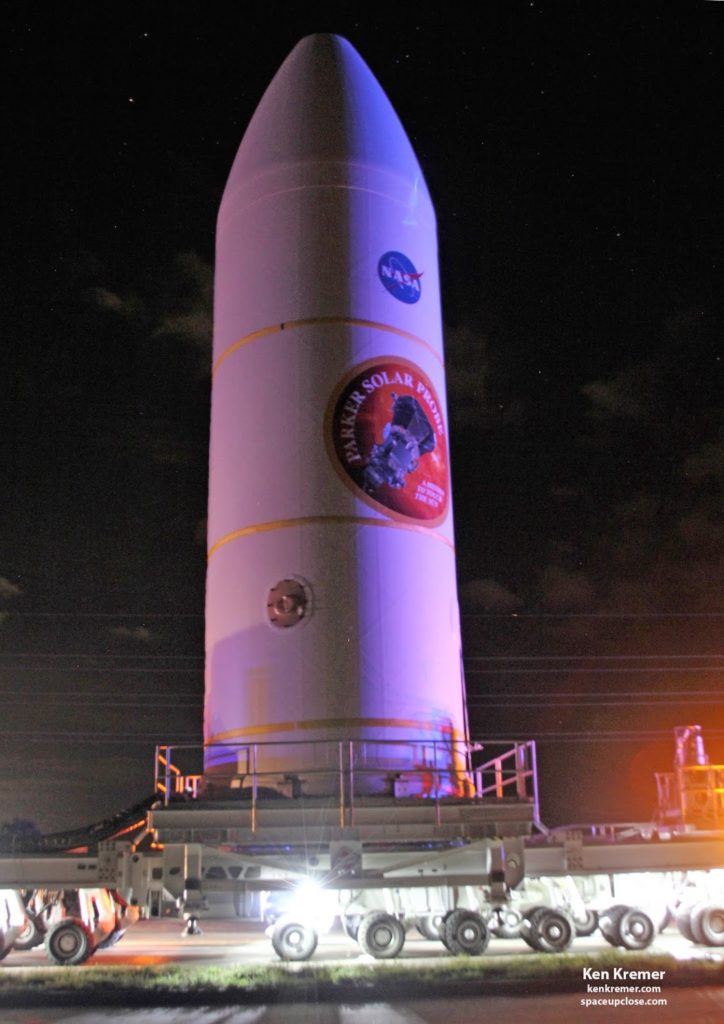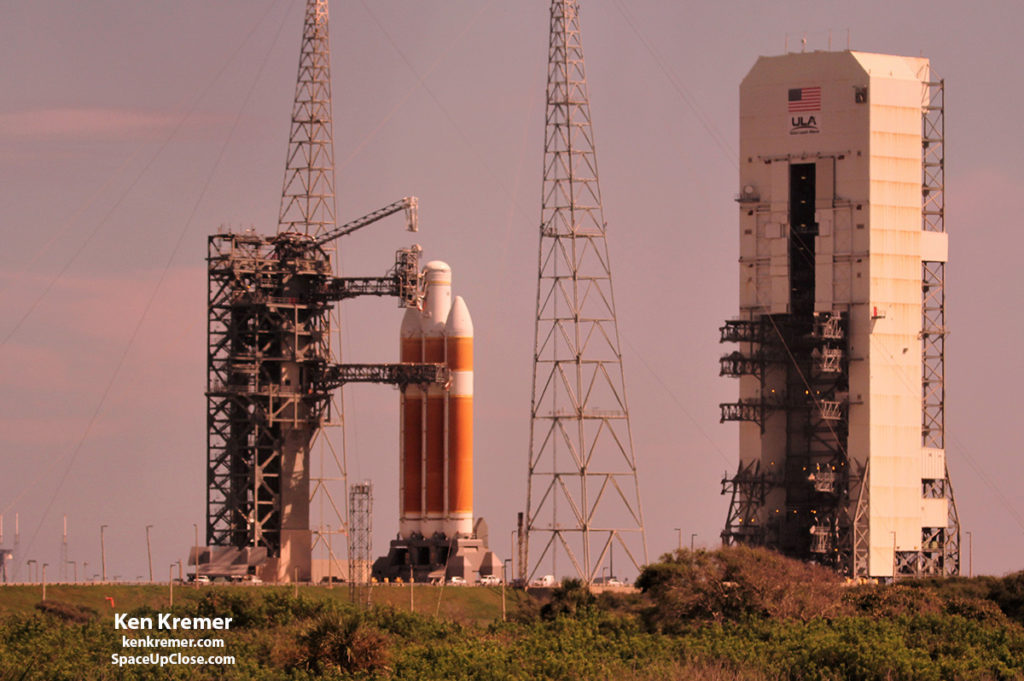Solar Probe spacecraft departed its prelaunch processing facility in Titusville
facility Monday night, July 30 encapsulated inside its humongous and protective
payload fairing, rolling to her Cape Canaveral, Florida launch pad and
targeting blastoff on August 11.
Escorted by a convoy of vehicles
and security forces led by rocket builder United Launch Alliance the 63-foot-tall (19-meter) stack of the fully fueled Parker Solar Probe and payload
fairing exited the Astrotech Space Operations payload processing facility processing facility around 830 p.m. Monday
night for a lengthy road trip on Rt 405 in Titusville, Florida that culminated with a
post-midnight arrival at Space Launch Complex-37 on Cape Canaveral Air Force.
Parker is on an unprecedented
mission to fly through the sun’s outer atmosphere — the solar corona – skimming within 4 million miles, 8.86 solar radii (6.2
million kilometers) of the suns
fiercely hot surface where it will encounter brutally hot conditions reaching
into the millions of degrees and extremely intense and deadly radiation.
of Space UpClose eyewitness rollout photos taken as the probe and vehicle convoy moved
at a snails pace of 4 mph along the roadway at night at a time when there is
less highway traffic.
slated for Aug. 11,
2018 atop the triple barrel United Launch Alliance Delta IV Heavy rocket, the
most powerful vehicle in the firms fleet, from
pad 37 on Cape Canaveral.
Liftoff is slated for the opening
of a launch window
that starts at 3:48 a.m. EDT (0748 GMT) and lasts for 45
minutes until 4:33 a.m. EDT (0833 GMT).
been delayed several times to deal with a variety of spacecraft technical and
payload processing issues from its originally planned July 31 liftoff date and
eaten into the 3 week launch period.
August 19 to get the spacecraft off the ground. So its getting close to the end
of the launch period after which it will have to sit on Earth until the next opportunity
for liftoff in May 2019.
Although the departure time was
not announced ahead of time for security reasons, there was a small crowd of
onlookers on hand at a few locations to wish her well along the way!
the white colored fairing consists of the Parker Solar Probe (PSP) integrated
on top of the third
stage rocket motor, a Star 48BV provided by Northrop Grumman, formerly Orbital
ATK.
The car-sized PSP is 3 meters
tall and has a mass of 1,424-pounds (646-kilograms).
 |
|
Parker Solar Probe sits inside half of its
fairing. Credit: NASA/Johns Hopkins APL/Ed Whitman |
As part of the final prelaunch
operations, technicians lifted and mated PSP onto the Star 48BV rocket motor on July 11.
third stage Star 48 BV rocket motor was added as an essential element required
to get enough thrust for PSP to leave the influence of the Earth’s gravity
field and fly within very close proximity of the sun to carry out its mission
to ‘Touch the Sun’.
stack was then encapsulated inside the bisector fairing at Astrotech on July
16, 2018.
 |
|
Parker Solar Probe was
encapsulated within its fairing on July 16, 2018, in preparation for its move to Space Launch Complex 37. Credit: NASA/Johns Hopkins APL/Ed Whitman |
triple stick ULA Delta IV Heavy is the worlds largest operational launch
vehicle and United Launch Alliance (ULA) was selected by NASA as the launch provider
several years ago.
use a third stage rocket to gain the speed needed to reach the Sun, which takes
55 times more energy than reaching Mars,” says NASA.
PSP convoy reached pad 37 after midnight Tuesday morning, July 31.
The
next step was to mount the satellite stack on top of the Delta IV Heavy rocket inside
the Mobile Service Tower (MST) to carry out the science
mission.
then quickly got to work and hoisted the PSP payload stack and integrated it on
top of the already waiting two-stage
approximately 179 foot tall (55 meter tall) Delta IV Heavy stack comprising two stages.
multiple vantage points in the Florida Space Coast region.
The
two stage Delta IV Heavy stack has already completed
a pair of critical Wet Dress Rehearsal (WDR) exercises conducted by engineers and technicians on July 2 and July 6 to
ensure that the rocket will be ready for the blastoff now currently targeted
for August 11 – as I reported here earlier.
out our exclusive Space UpClose photos of the two stage Delta IV Heavy stack on
the pad after the WDRs were successfully concluded.
the fairing and is on top of the Delta IV Heavy as of 12 Noon today,” said
Nicky Fox, Parker Solar Probe’s project scientist at the Johns Hopkins
University Applied Physics Laboratory, which developed the mission for NASA, at
a live media briefing held today at the University of Chicago.
Probe is go for the sun.”
fundamental questions about the nature of the sun and development an understanding
of how the sun works – such as why is the solar corona so hot. Its much hotter
than the suns surface.
the solar wind is accelerated to supersonic speeds.
NASA’s Parker Solar
Probe will fly ‘Where no Earth probe has gone before!’
Parker Solar Probe will swoop through the Sun’s atmosphere 24 times, getting
closer to our star than any spacecraft has gone before.”
sun’s outer atmosphere — the solar corona — to examine two fundamental
aspects of solar physics: why the corona is so much hotter than the sun’s
surface, and what accelerates the solar wind that affects Earth and our solar
system. Understanding these fundamental phenomena has been a top-priority
science goal for more than five decades. SPP will orbit the sun 24 times,
closing to within 3.9 million miles of its surface with the help of seven Venus
flybys,” says NASA.
services amounts to $389.1 million for a deal signed with the agency in
2015.
Heavy to launch the Orion EFT-1 test flight.
utilized to launch the heaviest clandestine payloads for national security
purposes for the USAF and NRO.
astrophysicist Eugene Parker, S. Chandrasekhar Distinguished Service Professor
Emeritus, Department of Astronomy and Astrophysics at the University of Chicago,
who predicted the existence of the solar wind in groundbreaking papers dating back to the 1958s.
Dr. Gene Parker developed a theory showing how the Sun’s corona is so hot that
it overcomes the Sun’s gravity, forming the solar wind,” says NASA.
for a living individual.
has never explored before,” said Thomas Zurbuchen, the associate administrator
for the Science Mission Directorate at NASA Headquarters in Washington. “This
mission will answer questions scientists have sought to uncover for more than
six decades.”
Watch for Ken’s continuing onsite coverage of NASA, SpaceX, ULA,
Boeing, Lockheed Martin, Orbital ATK and more space and mission reports direct
from the Kennedy Space Center, Cape Canaveral Air Force Station, Florida and
Wallops Flight Facility, Virginia.
Stay tuned here for Ken’s continuing Earth and Planetary science and human
spaceflight news: www.kenkremer.com
–www.spaceupclose.com – twitter @ken_kremer – email: ken at kenkremer.com
SpaceX Merah Putih & Telstar 19 launches, NASA/ULA
Parker Solar Probe, SpaceX Falcon 9/CRS-15 launch to ISS, SES-12 comsat launch, Falcon Heavy, TESS, GOES-S, Bangabandhu-1,
NASA missions, ULA Atlas & Delta launches, SpySats and more at Ken’s
upcoming outreach events at Kennedy Space Center Quality Inn, Titusville, FL,
evenings:
4-6: “SpaceX Telstar 19 &
Merah Putih Launches, NASA/ULA Parker Solar Probe SpaceX Dragon CRS-15 resupply
launch to ISS, SpaceX Falcon Heavy & Falcon 9 launches, SpaceX SES-12
comsat. ULA Atlas USAF SBIRS GEO 4 missile warning satellite, SpaceX GovSat-1,
CRS-14 resupply launches to the ISS, NRO & USAF Spysats, SLS, Orion, Boeing
and SpaceX Commercial crew capsules, OSIRIS-Rex, Juno at Jupiter, InSight Mars
lander, Curiosity and Opportunity explore Mars, NH at Pluto and more,” Kennedy
Space Center Quality Inn, Titusville, FL, evenings.
Photos for sale








